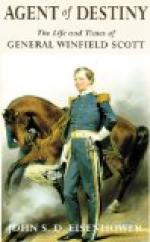him the names of First-Lieutenant F.B. Nelson
and Second-Lieutenant C.G. Gill, both of the
Second Tennessee Foot (Haskell’s regiment),
among the killed, and in the brigade one hundred
and six of all ranks killed or wounded. Among
the latter the gallant brigadier general himself
has a smart wound in his arm, but not disabled;
and Major R. Farqueson, Second Tennessee, H.F.
Murray, second lieutenant, G.T. Southerland,
first lieutenant, W.P. Hale, adjutant, all
of the same regiment, severely, and First-Lieutenant
W. Yearwood mortally wounded. And I know, from
personal observation on the ground, that First-Lieutenant
Ewell, of the Rifles, if not now dead, was mortally
wounded in entering, sword in hand, the intrenchments
around the captured tower. Second-Lieutenant Derby,
Topographical Engineers, I saw also at the same place,
severely wounded, and Captain Patten, Second United
States Infantry, lost his right hand. Major
Sumner, Second United States Dragoons, was slightly
wounded the day before, and Captain Johnson, Topographical
Engineers (now lieutenant colonel of infantry), was
very severely wounded in reconnoitering some days
earlier. I must not omit to add that Captain
Mason and Second-Lieutenant Davis, both of the Rifles,
were among the very severely wounded in storming
the same tower. I estimate our total loss in
killed and wounded may be about two hundred and
fifty, and that of the enemy three hundred and fifty.
In the pursuit toward Jalapa (twenty-five miles
hence) I learn we have added much to the enemy’s
loss in prisoners, killed, and wounded. In fact,
I suppose this retreating army to be nearly disorganized,
and hence my haste to follow in an hour or two to
profit by events. In this hurried and imperfect
report I must not omit to say that Brigadier-General
Twiggs, in passing the mountain range beyond Cerro
Gordo crowned with the tower, detached from his division,
as I suggested the day before, a strong force to
carry that height which commanded the Jalapa road
at the foot, and could not fail, if carried, to
cut off the whole or any part of the enemy’s
forces from a retreat in any direction. A portion
of the First Artillery under the often-distinguished
Brevet-Colonel Childs, the Third Infantry under
Captain Alexander, the Seventh Infantry under Lieutenant-Colonel
Plympton, and the Rifles under Major Loring, all under
the temporary command of Colonel Harvey, Second Dragoons,
during the confinement to his bed of Brevet Brigadier-General
P.F. Smith, composed that detachment.
The style of execution, which I had the pleasure
to witness, was most brilliant and decisive. The
brigade ascended the long and difficult slope of
Cerro Gordo, without shelter and under the tremendous
fire of artillery and musketry, with the utmost
steadiness, reached the breastworks, drove the enemy
from them, planted the colors of the First Artillery,
Third and Seventh Infantry, the enemy’s flag
still flying, and after some minutes of sharp firing
finished the conquest with the bayonet. It




